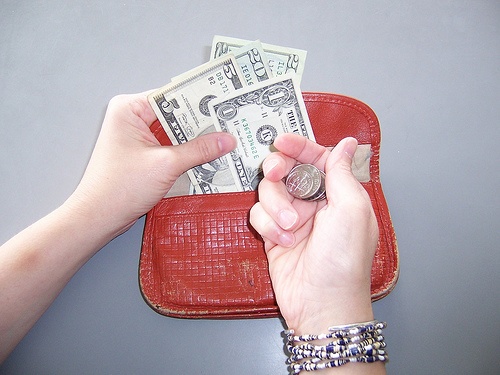By guest blogger, Gia Machlin
By now you probably know that I was not always a conscious consumer. To be precise, in the days Before EcoPlum (B.E.), I was quite an unconscious consumer. I used to shop for anything, anytime, with little to no regard for the environmental, personal health, or social impact of my purchases. I did not think about how much I was buying, let alone what the product was made of, how its ingredients might affect me or my surroundings, how it was packaged, and whether or not I really needed the product. It may be hard to believe, but this environmental advocate was at one time a consumerist hog.
After quite a bit of soul searching and of course a ton of awareness and education, I changed my wasteful ways and started buying less, researching the environmental and personal impact of my potential purchases, and understanding the social conditions of the workers who make the products I buy. I have advocated extensively for fair trade clothing, jewelry and food, safe cosmetics, organic clothing and food, non-toxic cleaning products and housewares. While building the shop at EcoPlum, I have curated all these types of products, along with those made of recycled and upcycled materials, and products that are made with environmental, socially responsible and health conscious practices in mind.
For a while after my “conversion,” I had zero tolerance for anything that did not meet my new standards. (What can I say? I’m a very passionate person!) I would scoff at anyone who bought bottled water. I stopped buying anything I didn’t truly need, bought only organic produce and meats, and used personal care products made with only the most natural and toxin free ingredients. I even made sure that my clothing was not made in sweatshops in developing countries.
Unfortunately, living this way is not very convenient and requires a lot of sacrifice. At times I became so obsessed with doing the ‘right thing’, that I was no longer thinking clearly. For example, if I was out with my daughter and we forgot to bring water (in a reusable bottle) and my daughter was thirsty, I refused to buy bottled water even if we could not find a water fountain or tap water nearby. My poor daughter had to go without drinking. What?? That’s not rational. Our planet’s plastic trash problem is not going to be effected one way or another by my occasional purchase of AquaFina® (but my daughter will probably be in therapy for a long time). So I started to relax my rules a little bit.
For example, I haven’t found a natural deodorant that I feel is strong enough for me. So rather than smell like a gym locker, I use an anti-perspirant product that may be causing harm to my body and sending toxins into the water supply. (Feel free to send me suggestions for a strong natural deodorant that works really well!)
Last summer, I didn’t say anything when my teenager went off to camp with shampoo and conditioner that I knew contained some harmful chemicals, because I realized that being a teenager is hard enough, and seven weeks of using this stuff was not going to kill him. And when I see that adorable sweater in the boutique window that fits perfectly and looks good with jeans, I may buy it even if it is not made of organic cotton or does not carry the fair trade label. I still use disposable tissues as I find hankies quite disgusting. You get the point.
If I didn’t allow myself these transgressions, I might find it hard to continue with my more conscious lifestyle and give it up altogether, and (heaven forbid!) go back to my wasteful ways from B.E. What’s important is that we make informed, conscious decisions, and understand the impact of our purchases on our health, the environment, and social justice. We should strive to do the best we can. We should spread the word, get involved and try to change regulation and policy. And, of course, celebrate all the great companies that make it easier rather than harder for us to make better choices.
A few years ago, those checking labels for chemical ingredients in their food, buying organic produce, or looking at the sustainability ratings of seafood were in the vast minority. Organic and natural foods were only available in “health food” and specialty stores and organic restaurants were practically unheard of. People were also buying their clothing at Target, H&M, Gap, and from designers without thinking about where and how it was manufactured. And while the food industry has undergone a slow but steady revolution, fast fashion has yet to slow down.
Thanks to slow food pioneers like Michael Pollen, Michele Obama, and Jamie Oliver, there’s been a wave of change around food. We’ve seen organic food sections of supermarkets and restaurants specializing in sustainable cuisine pop up everywhere, and we’ve even seen more sustainable choices in our children’s school food programs. But, for the most part, we still buy our clothing without thinking about the workers and the materials behind their production. Unfortunately, until the tragic collapse of a factory killed over 1000 women workers in Bangladesh this past April, few people were tuned in to the sustainability issues around fashion. That is beginning to change. I can only hope this is the start of a fashion revolution.
When thinking about the “sustainability” of any product, in this case clothing, it is helpful to consider three important elements:
1) The effect on the earth, nature and the environment
2) The personal health and safety impact on the consumer
3) The impact on the workers who make the product
The environmental component is probably the most well known aspect of the three elements I listed above. What materials were used in making the product? How much water and energy were consumed during the production process? How many miles did the product have to travel to get to the consumer? Is the product reusable, recyclable, or compostable, or does it leave behind a large footprint upon disposal? These are all critically important questions to be asking, and luckily we have reputable eco-labels and Life Cycle Analysis experts to guide us through the decision making process. But how much have you heard about the personal health impact of a cotton t-shirt or dress?
According to the Organic Trade Association, “Cotton is considered the world’s ‘dirtiest’ crop due to its heavy use of insecticides, the most hazardous pesticide to human and animal health. Cotton covers 2.5% of the world’s cultivated land yet uses 16% of the world’s insecticides, more than any other single major crop.” Really? And I put that shirt on my child? They go on to say that “during the conversion of cotton into conventional clothing, many hazardous materials are used and added to the product, including silicone waxes, harsh petroleum scours, softeners, heavy metals, flame and soil retardants, ammonia, and formaldehyde-just to name a few.” Wow! That should make you think twice next time you shop for camp clothing for your kids. Luckily there are companies that use GOTS certified organic cotton and other non toxic materials in their clothing. We sell many of those organic cotton clothing products at EcoPlum. And many manufacturers are starting to shift to less toxic production processes, which is great for those of us who don’t want to leach chemicals into our skin just from wearing clothing. But the part that, until this year, got the least attention was the third aspect of sustainability: how are the workers who made the article of clothing treated?
After the tragedy at the Rana Plaza factory in Bangladesh, H&M and other European companies signed the Accord on Fire and Building Safety in Bangladesh, but US companies refused to sign it. As it turns out, just an hour ago (while I was writing this post), the NY Times reported that 17 major US retailers, including Walmart, Gap, Target and Macy’s, announced their plan to improve factory safety in Bangladesh: The Bangladesh Worker Safety Initiative. I haven’t read it yet, but critics are saying it is much less stringent than the European plan. Still, this is great news. But as long as there are workers in developing countries making our clothing, it is important that we find out more about the conditions of those workers before making a purchase. One good way is to purchase clothing from companies that are members of the Fair Trade Federation, Green America Certified, or otherwise transparent about the fair treatment of the people who make their products.
I know this is a lot to think about when making a clothing purchase, but if we make these mindful decisions and evolve as consumers, the fashion industry will have to follow suit.
 Gia Machlin, president and CEO of EcoPlum, an online green shopping rewards site. Watch for her contributions to the CSRHub blog on eco-friendly products and green living ideas. For more on EcoPlum, or to follow the EcoPlum blog, visit www.ecoplum.com.
Gia Machlin, president and CEO of EcoPlum, an online green shopping rewards site. Watch for her contributions to the CSRHub blog on eco-friendly products and green living ideas. For more on EcoPlum, or to follow the EcoPlum blog, visit www.ecoplum.com.

